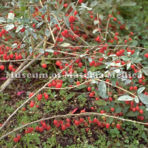Lycium Bark

|
Market name:地骨皮 Photo location:Museum of Materia Medica, Inst. of Nat. Med. TMPW No.:13691 |

|
Plant name:Lycium chinense Photo location:Toyama Pref., Japan Photo date:1994 Photographer:K. Komatsu |
| Synonym | |
| Latin name | Lycii Cortex |
| Botanical source: Family name | Solanaceae |
| Botanical source: Plant name | - Lycium chinense Miller (IPNI:816389-1) - Lycium barbarum Linné (IPNI:816356-1) |
| Part used | Root bark |
| Empirical criteria for quality selection | Good one is vorticose root bark which was made from a thick root. (TN) |
| Constituents | Amino acids: Betaine |
| Pharmacological effects | Transient increase in the blood sugar, antipyretic. |
| Indications | As an antifebrile and tonic, it is applied to treat afternoon fever and night sweat in tuberculosis, cough, hematemesis, diabetes, excessive perspiration due to deficiency of yin. |
| Diseases | Fever, Night sweats, Cough, Rapid breathing, Sputum with blood, Hemoptysis, Hematemesis, Nasal hemorrhage |
| Formulas | ogibekkoto , jiinshihoto , jingyobekkoto , seishinrenshiin |
| Meridian tropism | Lung, Kidney |
| Property | Cold |
| Flavor | Sweet, Bland |
| Classification in "Shen-non Ben-cao Jing" | Superior |
| TCM: Classification | Antipyretics |
| TCM: Medicinal effects | To reduce heat in blood, to relieve consumptive fever, and to remove heat from the lung.: Used for afternoon fever and night sweat in consumptive diseases, cough, hemoptysis and epistaxis due to heat in the lung, diabetes caused by internal heat. |
| Remarks | Listed in the Japanese Pharmacopoeia 18th ed. |
| References | TN: T. Namba & Y. Tsuda ed., Outline of Pharmacognosy, a Textbook, 3rd ed., Nankodo Co., Ltd., Tokyo, 1998. |
DNA sequences of medicinal plants
| Gene Region | |||||||||||||||||||
| Nuclear | Chloroplast | Mitochondria | |||||||||||||||||
| Botanical source: Plant name | 5Ss | 18S | ITS1 | 5.8S | ITS2 | 26S | others | trnH-psbA | matK | trnK | trnK-rps16 | trnT-L | trnL | trnL-F | rbcL | rpoC1 | ndhF | others | |
|
|
|||||||||||||||||||
|
|
|||||||||||||||||||
